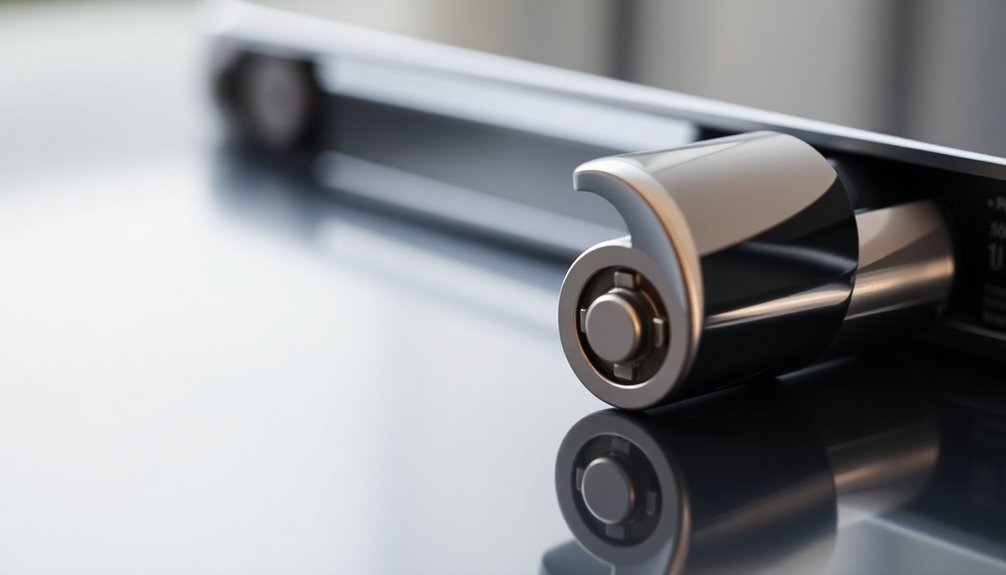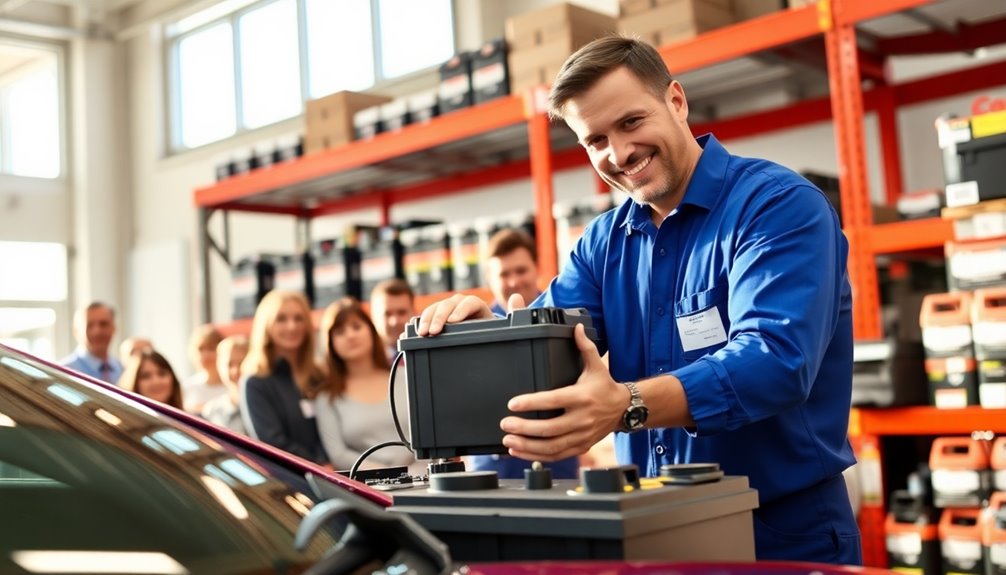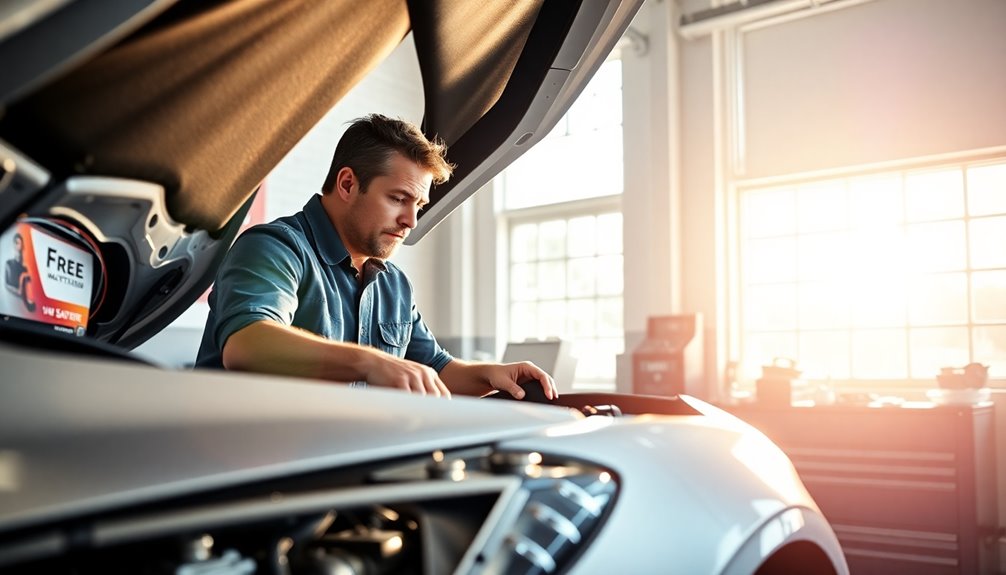To avoid costly mistakes when installing a battery, it's essential to connect the terminals correctly. Always attach the positive terminal first, typically marked with a red cover, followed by the negative terminal, marked with black. This guarantees you avoid electrical sparks and potential damage. Disconnect the negative terminal first when removing the battery and reconnect the positive terminal last. Confirm the terminals are clean and snug, but don't overtighten. Following these steps will keep your installation safe and efficient. There's a lot more to learn about battery care and maintenance that can save you time and money.
Key Takeaways
- Identify the positive (+) and negative (-) terminals correctly to avoid reverse polarity connections.
- Disconnect the negative terminal first to minimize the risk of sparks during battery work.
- Always connect the positive terminal last to ensure safety and proper functionality.
- Regularly inspect and clean terminals to prevent corrosion and ensure secure connections.
- Follow the order: "Get rid of negativity, hold onto positive" for safe installation and removal.
Understanding Battery Orientation
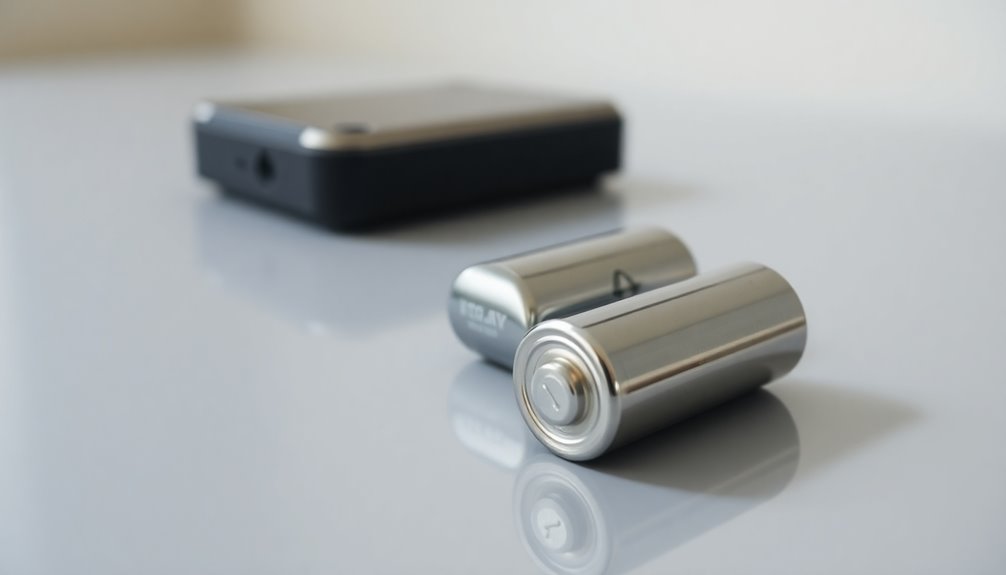
When you're dealing with car batteries, understanding the correct orientation is crucial to avoid costly mistakes. Car batteries have positive (+) and negative (-) terminals, which you must connect correctly. The positive terminal is usually larger and marked with a red cover, while the negative terminal is smaller and often has a black cover.
Incorrect connections can lead to reverse polarity, triggering the battery light on your dashboard and causing electrical shorts or blown fuses. To properly replace a battery, disconnect the negative terminal first and connect the positive terminal last.
Always double-check that the battery is seated correctly and that terminals are tightened securely. This guarantees a reliable electrical connection and minimizes the risk of damage to your vehicle's electrical system.
Importance of Safe Handling
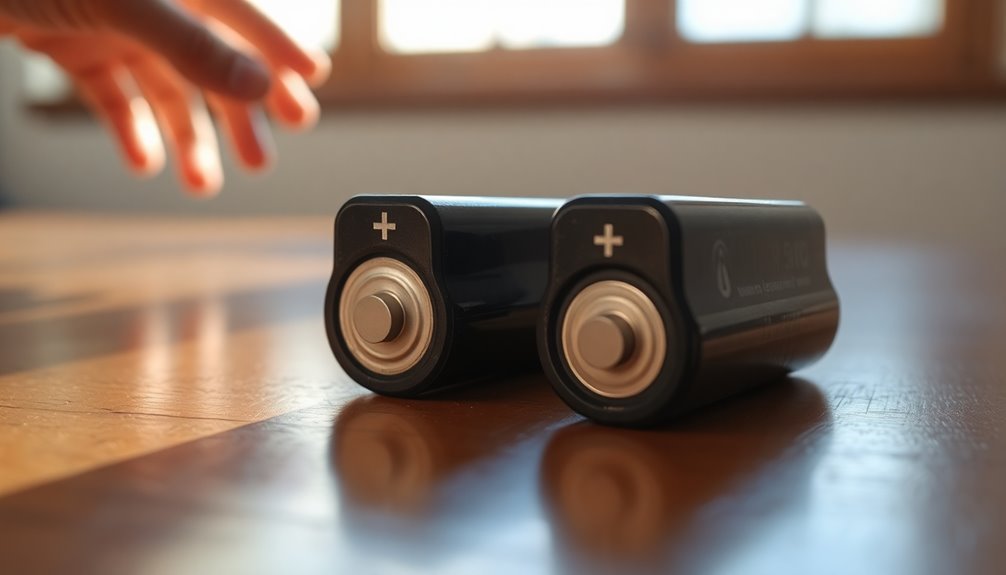
Proper battery orientation sets the stage for safe handling practices. When dealing with car batteries, it's vital to prioritize your safety. Here are three essential tips to keep in mind:
- Wear safety gloves and goggles: Protect yourself from corrosive battery acid and potential sparks.
- Ensure proper ventilation: Always work in a well-ventilated area to avoid inhaling harmful gases emitted from the battery.
- Avoid simultaneous contact with terminals: Never touch both terminals with metal tools to prevent short circuits and possible explosions.
Regularly inspect battery seals and terminals for corrosion or leaks, as these issues can pose serious hazards.
Step-by-Step Disconnection
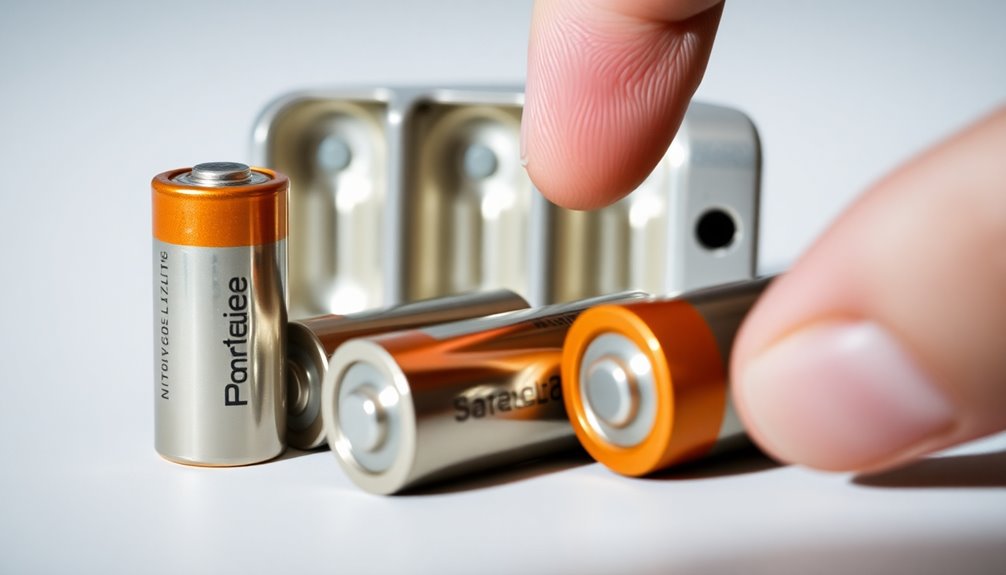
Disconnecting a car battery doesn't have to be complicated, but it is crucial to follow the right steps to guarantee safety. Start by turning off the ignition and all electrical components. Identify the positive (+) and negative (-) terminals before proceeding.
Here's a quick reference table:
| Step | Action | Notes |
|---|---|---|
| 1. Turn Off Components | Confirm all electronics are off | Prevents electrical shorts |
| 2. Identify Terminals | Locate + and – terminals | Be cautious |
| 3. Remove Negative Terminal | Loosen and remove – first | Reduces spark risk |
| 4. Remove Positive Terminal | Loosen and remove + next | Store away from metal surfaces |
Always wear safety gloves and goggles. Once disconnected, you can safely install your new battery.
Common Installation Mistakes
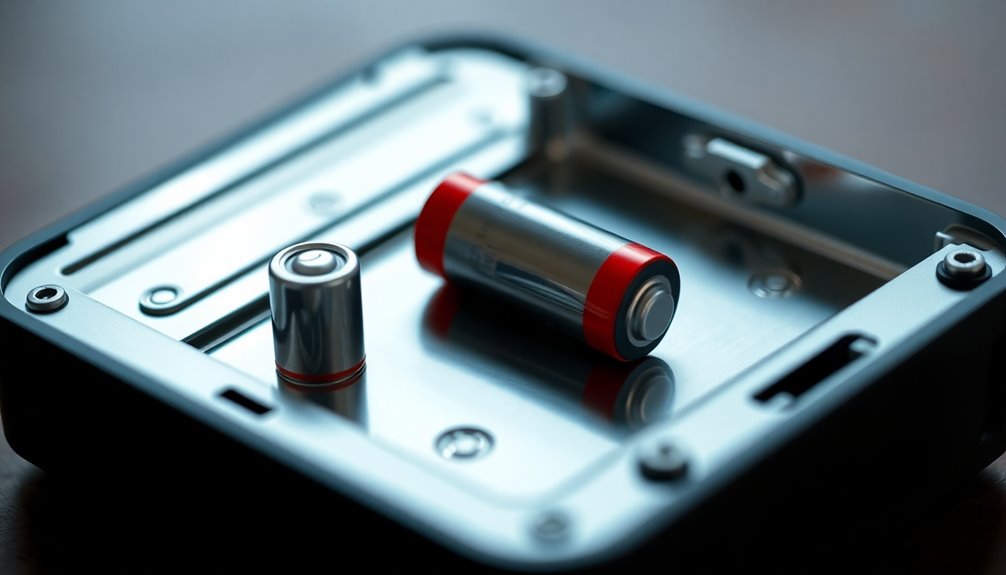
When installing a battery, it's easy to make common mistakes that can lead to bigger issues.
Connecting the terminals in the wrong order or neglecting to clean them can hinder performance and safety.
Plus, you've got to guarantee the terminals are snug but not over-tightened to avoid damage.
Incorrect Terminal Connection Order
If you want to guarantee a safe battery installation, it's crucial to connect and disconnect terminals in the correct order. Ignoring this can lead to electrical sparks or even short circuits.
Here's how to do it right:
- Disconnect the negative (-) terminal first to minimize risks.
- Reconnect the positive (+) terminal first when putting the battery back.
- Remember the mnemonic: "Get rid of negativity, hold onto positive" to recall the correct order.
If you skip these steps, you might face issues that could force you to buy a new battery sooner than expected.
Always make sure your terminals are tight but not overtightened to avoid damage.
Follow these guidelines for a smooth and safe battery experience!
Neglecting Terminal Cleanliness
Connecting your battery correctly is just one part of ensuring its ideal performance; neglecting terminal cleanliness can lead to significant issues. Corrosion buildup on terminals can impede electrical flow, causing starting problems or even battery failure, especially with an old battery. Here's a quick reference on the impacts of neglecting terminal cleanliness:
| Impact | Result |
|---|---|
| Corrosion Buildup | Impeded electrical flow |
| Increased Resistance | Overheating risk |
| Poor Contact | Intermittent electrical issues |
| Damage | Harm to battery and components |
| Warranty Void | Potential loss of coverage |
Regularly inspecting and cleaning terminals with sandpaper or a wire brush helps maintain a strong connection, prolonging your battery's life and ensuring reliable performance. Don't overlook this essential step! Additionally, keeping your battery in optimal condition can prevent major repairs that might arise from neglecting such maintenance.
Overlooking Tightness of Terminals
One common mistake many people make is overlooking the tightness of battery terminals. Loose connections can lead to intermittent electrical issues, draining your battery faster.
On the flip side, over-tightening can damage soft metal components, causing cracks and breakage. Here are three tips to guarantee proper tightness:
- Secure Fit: Make sure the terminals are tight enough that they can't spin by hand.
- Check for Gaps: Look for any air gaps in the clamps; these indicate insufficient tightness.
- Proper Seating: Use a small hammer to guarantee terminals are seated well at the post base before tightening.
Proper Terminal Maintenance

Proper terminal maintenance is essential for guaranteeing your battery operates efficiently and safely.
Always connect your terminals in the correct order: remove the negative (-) terminal first and reconnect the positive (+) terminal finally to prevent sparks.
Regularly clean your battery terminals with sandpaper or a wire brush to eliminate corrosion that can hinder current flow.
When tightening terminals, make sure they're secure enough to prevent spinning without overtightening, which might damage the terminal.
Check for an air gap in the clamp after tightening to guarantee a proper fit, confirming the terminal is fully seated.
Finally, inspect battery seals for leaks, as old batteries can leak acidic fluid, corroding terminals and posing safety risks.
Resources for Further Learning

How can you guarantee you're making informed decisions about battery maintenance? Start by tapping into various resources that offer valuable insights.
Here are three great ways to enhance your knowledge:
- YouTube: Check out step-by-step tutorials on battery installation and maintenance for visual guidance.
- Automotive Forums: Engage with communities where experienced DIYers share tips and answer your battery-related questions.
- Educational Websites: Access reputable automotive organizations that provide articles and videos on best practices.
Additionally, consider using apps with diagnostic tools to identify battery issues before you think about replacement.
With these resources at your fingertips, you can confidently handle your free battery and avoid costly mistakes!
Frequently Asked Questions
Which Way Should Batteries Go In?
When you're installing batteries, make sure the positive (+) terminal matches the positive connection, and the negative (-) terminal aligns with the negative.
Most batteries have clear markings to guide you, so check those before inserting them. If your device uses multiple batteries, follow the diagram inside the compartment.
Double-check everything before closing it up to avoid any issues. Incorrect installation can cause damage, leaks, or even hazards, so it's worth being careful!
How Do Batteries Prevent Overcharging?
Batteries are like smart little guardians, making sure they don't get too much love during charging. They use built-in voltage regulators and smart charging features to keep things balanced, adjusting the current based on their needs.
For lead-acid types, a specific gravity measurement tells you when they're full, while lithium-ion batteries rely on a Battery Management System to monitor everything.
Regular checks help them stay happy and healthy, avoiding any overheating mishaps!
What Happens if You Put Batteries in the Wrong Direction?
If you put batteries in the wrong direction, your device mightn't work at all. Some devices have protection circuits, but others can sustain damage.
Reversed polarity can lead to overheating, leakage, or even explosions, particularly with rechargeable batteries. You might also cause a short circuit, blowing fuses or tripping breakers.
To avoid these issues, always check the polarity markings in the battery compartment before inserting your batteries.
Does the Positive or Negative Side of the Battery Go Against the Spring?
Imagine you're trying to power up your favorite toy, but it won't turn on. You might've installed the batteries incorrectly.
In most cases, the positive side of the battery goes against the spring. This setup guarantees a proper connection, allowing your device to function correctly.
Always check for markings in the battery compartment to avoid frustrating mishaps. Getting it right prevents overheating and potential damage to your batteries and device.
Conclusion
So, next time you grab a battery, remember—positive goes to positive, and negative to negative. It's easy to overlook, but getting it wrong can lead to costly mistakes or even damage. You might think it won't happen to you, but that's exactly what someone else thought before they accidentally fried their device! By staying informed and cautious, you'll save yourself time, money, and frustration. Trust me, you don't want to learn this lesson the hard way!

